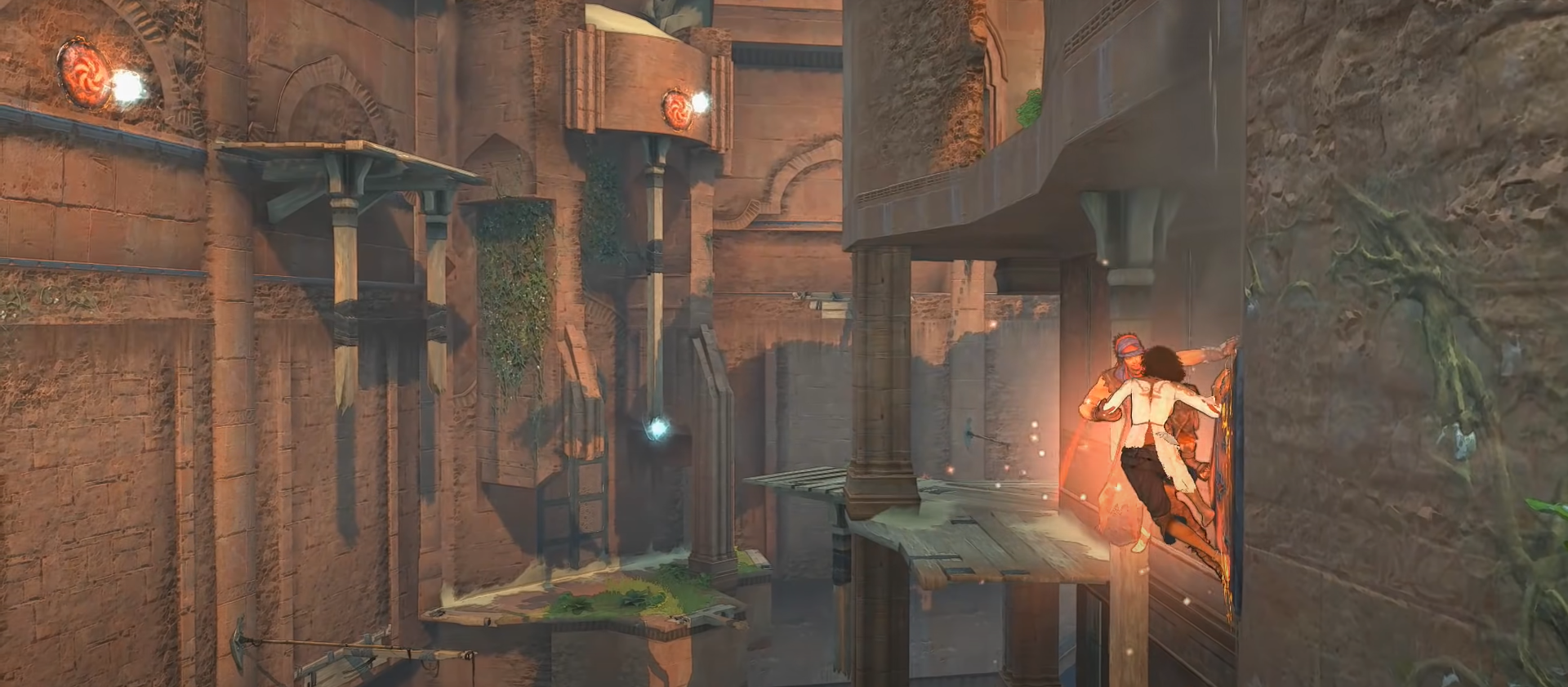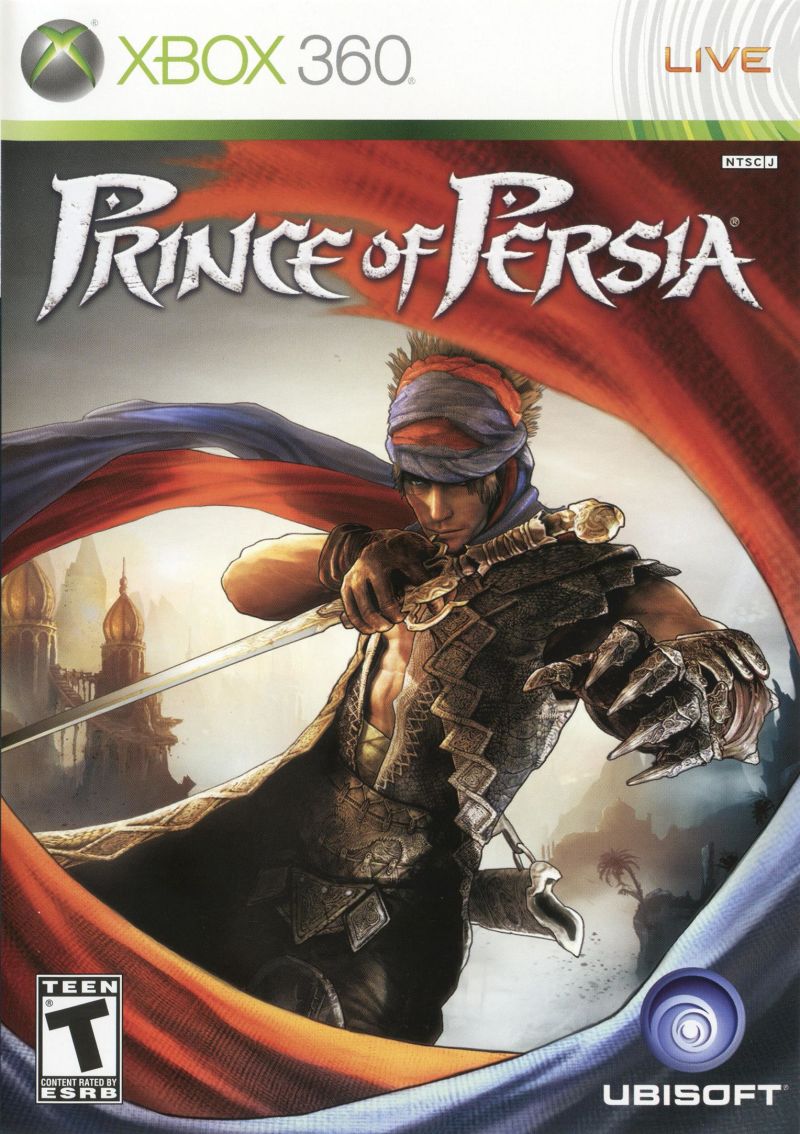

“They’re not trying to kill us. They’re trying to kill you.”
If you took a gamer with the concentration and fine motor skills required to be a pro at online FPS games and gave them like twenty minutes to familiarize themselves with Prince of Persia, they could conceivably run through the short campaign without making a single mistake. It’s just not that difficult of a game (unlike the 1989 original for the Apple II). While parkouring your way around the fantastical ancient ruins, often exposed to thousands of feet of open air beneath you, there’s basically only one correct way to maneuver the titular nameless hero. Press the right sequence of buttons with the right timing and you’re golden. Since there are but a few action buttons to choose from and they never need to be pressed in quick succession this is generally very easy. Accidentally flub the button press—or, as happens far more frequently, see the game shoehorn you into the wrong line of action—and you’ll find yourself plummeting to your gruesome death. Just kidding. There’s a magical princess named Elika who will teleport to you and pull you back to safety like Nightcrawler in X2.
You literally cannot lose even if you try. It’s kind of novel to retcon the player’s failures into a diegetic feature. The two lead characters recognize that Elika has saved the player’s butt however many times and one of the final bosses creatively takes the subversion into account. But the game over screen—however impactful on the player’s progress—is a standard element that forces (or at least encourages) improvement. Its removal, even though it is mostly symbolic, saps all sense of pressure, risk, and urgency. Mess up and you’ll get a do-over starting from your last point of contact with flat ground, all other measurable progress left in-tact. But the thing is that the game is so streamlined and languid already that childproofing it further by erasing player deaths via Elika totally sucks all sense of triumph out of it. You haven’t conquered, merely endured.
The freerunning does not require the intricate control and dexterity of Mirror’s Edge. Or even Tomb Raider or Assassin’s Creed. No, all that it takes to make it look like you’re a pro is some loose joystick work and a button press every two or three seconds. All the fancy extraneous footwork that makes gameplay appear to be fun and involved is the game on autopilot. This is like playing Guitar Hero on easy mode and hearing Jimi Hendrix coming out of your TV speakers. Your input doesn’t even get instant feedback in game. You log your solitary button press, the prince sluggishly performs a canned animation, then a generous window opens in which he moves in slow motion for you to press the next button. If you’ve done what the game wanted, you’ll autolock onto the next interactive piece of the environment. If not, here comes Elika. This creates a yuge disconnect between the player and the avatar. In good action games the player is immersed to a degree that they can get in the zone and feel momentarily merged to the character they are controlling. In Prince of Persia it feels more like you’re suggesting actions to the Prince that he may or may not do—i.e. you’re not really in control, and so you feel detached from the action.
Considering the actual inputs required to traverse the crumbling remnants of ancient Persia are next to nothing, but also the hit-or-miss nature of those inputs, the flubs are all the more glaring. You won’t barely miss grabbing a ledge or let go of your monkey-bar swing at the wrong moment. No, you’ll wall-run horizontally when you want to go vertical. You’ll push off from a ledge and jump out into the open sky when you want to muscle up onto the flat surface above you. There’s a constant tension between the camera and the prince’s orientation making joystick work a guessing game. Even if you account for the rigidity of the approach there’s no leeway for correcting your own minor errors. There’s no “by the skin of your teeth.” It’s either perfect execution or Elika catching you as you fall towards your doom.
I don’t even want to comment on the game’s “plate” system which sees you flying through the air with a blurred screen and no control over the camera and running across walls and ceilings like a lethargic Sonic the Hedgehog. It’s just a lame addition for the sake of “magic” that actively detracts from whatever modicum of joy there is to be had.
All of the things that plague the freerunning portion of the game are rampant in the dreadful combat sections as well. But whereas the lack of skill needed to perform the parkour sections is somewhat obscured, it is plainly evident when fighting. In a series of several dozen one-on-one (or two-on-one, counting Elika) battles with only five different enemies, you’ll probably experience about a thousand quick-time events—pauses in the action where a prompt comes up on the screen telling you to press one of the four face buttons. This is the same as freerunning but now they give you a silly icon instead of making you interpret the environmental features. But combat has an even bigger problem. As you get further into the game the bosses become bolder, meaning the final boss fight will feature like a hundred quick-time events. As is the case with the acrobatics, the combat can look like great fun if you’re not playing but it’s really just a series of button press, long pause, button press, long pause, rinse, repeat, so braindead that it maybe should have been cut altogether.
So actually playing the game is not fun. I think I’ve pretty well established that. But does it do anything well? Yes, actually. I’ll mention those items briefly. Though I’m not typically a graphics guy, I happen to be a sucker for cel-shading and the visual flair on display here is very pleasant. The game world and the prince moving through it both tend to look amazing and manage to strike a balance between “realistic” and cartoonish. The contrast of the corrupted worlds to those that Elika has healed provides a visual sense of progression. Stuart Chatwood and Inon Zur’s cinematic score is also very good. While the myth-drenched plot barely bears mentioning—Elika is descended from a clan of guardians sworn to keep an evil god trapped in his prison… and he’s about to break out!—there are literal hours of playful banter recorded between Nolan North and Kari Wahlgren that adds some levity to things (even if a wise-cracking American depicting a Persian prince kind of undercuts the game’s atmosphere). Mentioning the story reminds me that it ends splendidly. It was truly a terrific narrative choice that wrings more emotional punch out of the flimsy characters than I thought possible. But then it veers off into a “shocking” twist and hangs the player from a cliff, enticing them to buy the true ending which is locked behind $10 of DLC. I’ll pass.
If you can confidently say that you’ve experienced all a game has to offer less than an hour in, it’s either not very good or it’s from the ‘80s—and in the latter case you’re probably almost done with it. It would be one thing if you scrapped your way through the first few levels and were looking to hone your skills as the difficulty increased, new enemies appeared, the plot thickened—but that’s not the case here. Once you’ve mastered the kid-friendly controls all that’s left is to crank through a couple dozen repetitive levels. And since the first level felt like riding a bike with training wheels, there’s just nothing here for anyone remotely familiar with video games.
What’s strange is that many critics LOVED this game even though it is mechanically a heap of trash. Many game of the year claims, plenty of 9 out of 10s. At least one reviewer stated that they wanted to marry Elika. Maybe this reinforces the perception that reviewers don’t finish the games they review, that they care primarily for aesthetics, that they’re generally bad at video games, or that they just shill for the AAA companies. I’m all for the chill-out, cel-shaded, free-running, orb-collecting vibe. But that can’t sustain a full-length game nor can it cover up the myriad shortcomings. It’s not a crime to say that a game excels in some aspects but fails so badly in other areas that it is a bad game on net. And that’s the case here. Beautiful art direction trying to disguise terrible game design.